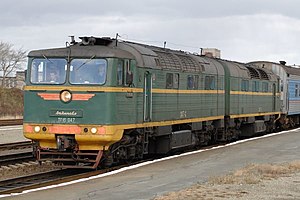SŽD series ТГ16
| SŽD series ТГ16 (TG16) | |
|---|---|
|
ТГ16-047
|
|
| Numbering: | ТГ16-001 to ТГ16-095 |
| Number: | 95 |
| Manufacturer: | Diesel Locomotive Factory Lyudinowo ( Lyudinowo ) |
| Year of construction (s): | 1966-1974 |
| Axis formula : | B 'B' + B 'B' |
| Gauge : | 1067 mm (ТГ16-001: 1520 mm) |
| Length over coupling: | 30,900 mm |
| Height: | 4080 mm |
| Width: | 3000 mm |
| Service mass: | 140 t |
| Top speed: | 85 km / h |
| Installed capacity: | 2412 kW |
| Driving wheel diameter: | 950 mm (ТГ16-001: 1050 mm) |
| Motor type: | М756АС |
| Power transmission: | hydraulic |
| Number of traction motors: | 2 |
The locomotives of the class ТГ16 (German transcription TG16) of the Soviet Railways (SŽD) are narrow-gauge diesel locomotives for use on Sakhalin .
development
To replace the still from Japan time coming steam locomotives of the series Д51 that the brunt of traffic on the for Japan typical Cape gauge ( track width 1067 mm) operated Sakhalin Railway contributed, began the construction of diesel locomotives early 1960s. Both one-piece and double locomotives were planned.
The basis for the development was the ТГ102 (TG 102) series, built since 1959, in the version ТГ102К (TG102K) built since 1962, which appeared to be the most suitable for adapting to Cape gauge due to its relatively light design and space-saving hydraulic power transmission. The prototype of a double locomotive was built in 1966 at the Ljudinowo diesel locomotive factory under the number ТГ20-001, for experimental purposes in a broad gauge version (1520 mm). This locomotive was tested from Leningrad together with different variants of ТГ102. This prototype was later given the number ТГ16-001, but always remained broad gauge.
The second prototype was ТГ16-002 in Cape gauge design. She arrived in Sakhalin in April 1967. Compared to the ТГ102 series, the redesigned front with the roof pulled down over the driver's cab was the most striking. The plans for the one-piece variant ТГ14 (TG14) were no longer pursued. It was therefore necessary to equip the ТГ16 locomotive halves independently and to install headlights at the transitions.
Series production then began. A total of 95 ТГ16 had been built by 1974. During the construction of the series, changes were made to the bogies several times.
commitment
With the ТГ16 the almost complete replacement of the D51 succeeded, one ТГ16 could replace three D51s. The ТГ16 are used for express and passenger trains as well as for freight transport. Due to some line closures, the demand decreased over the years, in 2001 there were still 37 locomotives and four locomotive halves in stock.
The most important changes during the operation were the replacement of the type М756АС (M756AS) motors with those of the type М756В and the replacement of the originally rotating front windows with flat ones that were exclusively located within the front surface. The latter was necessary because the panes on the sides could not withstand the pressure in high snowfall.
The series ТГ21 (TG21; double locomotive) and ТГ22 (TG22; single locomotive ) were planned as successors to the ТГ16 , of which one and seven were built from 1992, respectively. Various problems with these locomotives meant that they were no longer built. Since the re-gauging of the railway network on Sakhalin to broad gauge has now been specifically planned, there are no plans for a direct successor to the ТГ16.
literature
- P. Kashin, W. Botschenkow, W. Balabin, L. Moskalev: Nashi uskokolejnyje teplowosy i elektrowosy, Tschast I . Schelesnodoroschnoje Delo, Moskwa 2003, ISBN 5-93574-013-3 .
- Vitaly Alexandrowitsch Rakow: Lokomotiwy i motorwagonny podbischznoj sostaw schelesnych dorog Sowetskogo sojusa. 1966–1975 vs. Transport, Moskwa 1979.
